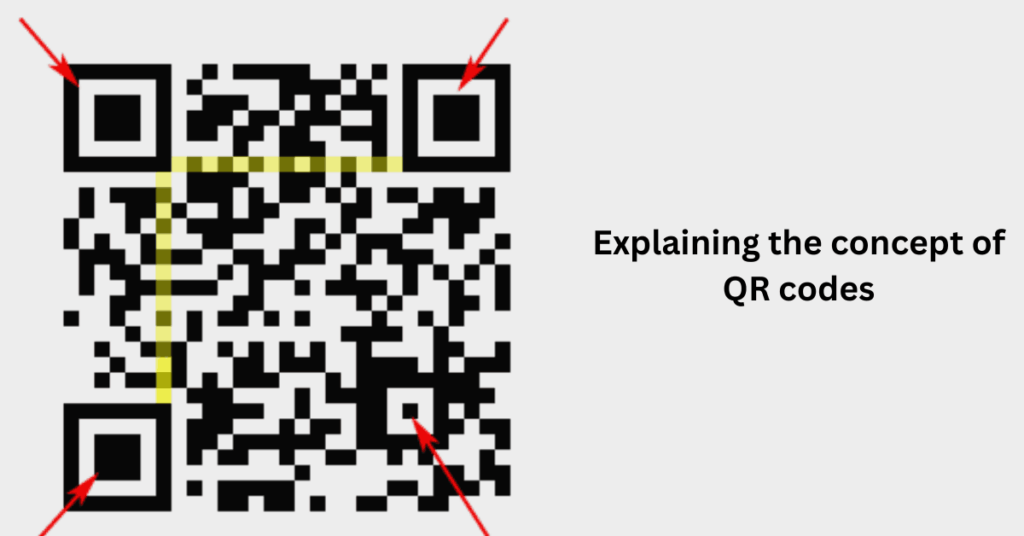Explaining the concept of QR codes In 2024

In our digitally driven world, Quick Response (QR) codes have become a ubiquitous feature of daily life, seamlessly connecting the physical and digital realms.
The concept of QR codes is rooted in simplicity yet holds immense versatility, allowing for a myriad of applications across various industries.
Let’s delve into the concept of QR codes and unravel the magic behind these square-shaped, pixelated patterns.
Table of Contents
What is a QR Code?
A QR code is a two-dimensional matrix barcode that stores information in a machine-readable format. Initially developed in 1994 by Denso Wave, a subsidiary of Toyota, for tracking automotive parts during manufacturing, QR codes have since evolved into a versatile tool for encoding various types of data.
Structure and Components:
A standard QR code consists of black squares arranged on a white square grid. The arrangement of these squares encodes information in both the horizontal and vertical dimensions. Key components of a QR code include:
- Finder Patterns: These are the square patterns at three corners of the QR code that help scanning devices locate and orient the code.
- Timing Patterns: These assist in defining the size of the QR code cells, ensuring accurate decoding.
- Alignment Patterns: These are additional patterns used for larger QR codes, aiding in error correction.
- Quiet Zone: The white border around the QR code, known as the quiet zone, ensures that surrounding elements do not interfere with scanning.
- Data Cells: The black squares that encode the actual data in the QR code.
Types of QR Code Content:
QR codes can encode various types of information, making them versatile in different contexts. Common types of QR code content include:
- URLs: Direct users to websites or landing pages for additional information.
- Text: Encode plain text, allowing for the quick sharing of information or messages.
- Contact Information (vCard): Store contact details such as name, phone number, and email address.
- Wi-Fi Configuration: Encode Wi-Fi network details for easy device connectivity.
- Geographic Coordinates: Specify geographical locations using latitude and longitude coordinates.
- Email Addresses: Create QR codes that, when scanned, initiate an email to a specified address.
- Calendar Events (vCalendar): Encode event details like date, time, and location.
- SMS Messages: Generate QR codes that, when scanned, open the messaging app with a predefined message.
- Business Cards (MeCard): Similar to vCard, MeCard encodes contact information for easy sharing.
How QR Codes Work:
The functioning of QR codes relies on a simple principle: the ability of scanning devices, such as smartphones or dedicated QR code scanners, to interpret the pattern of black and white squares. When a scanning device captures the QR code, it analyzes the arrangement of squares to decode the encoded information.
QR codes employ error correction techniques, allowing them to remain functional even if a portion of the code is damaged or obscured. This resilience ensures reliable data retrieval under various conditions.
Applications of QR Codes:
The versatility of QR codes has led to their widespread adoption across diverse industries:
- Marketing and Advertising: QR codes are used in advertisements, posters, and product packaging to provide consumers with instant access to additional information, promotions, or websites.
- Contactless Payments: In the realm of mobile payments, QR codes facilitate secure and convenient transactions, allowing users to scan and pay without physical contact.
- Event Ticketing: QR codes on event tickets streamline entry processes, enhance security, and provide organizers with real-time attendance data.
- Inventory and Logistics: QR codes are employed in supply chain management for tracking and managing inventory, ensuring efficient logistics.
- Healthcare: In healthcare, QR codes on medical records, prescriptions, and patient wristbands enhance data accuracy and accessibility.
- Education: Educational materials, textbooks, and classrooms utilize QR codes to provide students with supplementary content, videos, or interactive resources.
- Tourism: QR codes on tourist attractions or maps offer visitors quick access to relevant information, audio guides, or virtual tours.
Creating and Scanning QR Codes:
Creating a QR code is a straightforward process using online generators. Many platforms allow users to input desired content, customize the appearance, and generate QR codes for free. To scan a QR code, users can use the built-in camera on smartphones or dedicated QR code scanner apps.
Conclusion:
The concept of QR codes epitomizes the fusion of the physical and digital realms, offering a powerful and versatile tool for encoding information in a compact, machine-readable format. As technology continues to advance, the applications of QR codes will likely expand, shaping the way we interact with information and seamlessly connecting the offline and online worlds.